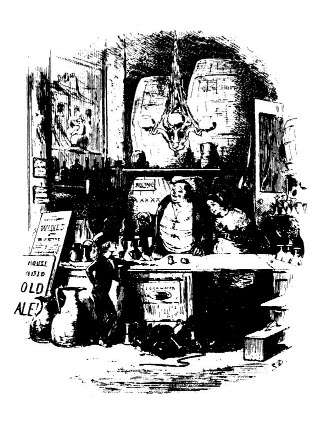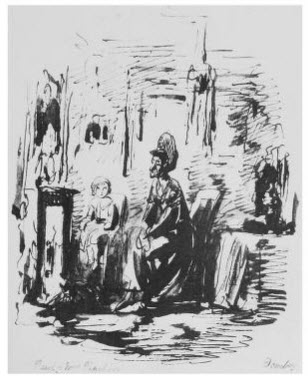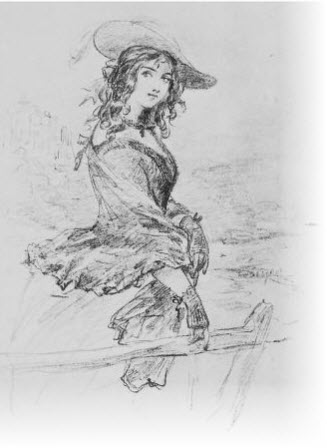A LIST OF THE PRINCIPAL WORKS ILLUSTRATED BY PHIZ.

An Illustration from David Copperfield, by Phiz
To enumerate all the works illustrated by "Phiz" would be a next toimpossible task, for "their name is legion." No artist was so popular orso prolific as a book-illustrator, with the exception, perhaps, ofGeorge Cruikshank. It may fairly be questioned whether the works ofCharles Dickens, with which the name of "Phiz" is most intimatelyassociated in our minds, would have achieved such notoriety without theaid of the etching needle so ably wielded. Mr. John Hollingshead, in hisessay on Dickens, says:--
"The greater the value of a book as a literary production, the more willthe circle of its influence usually be narrowed. The very shape, aspect,and garments of the ideal creatures who move through its pages, evenwhen drawn by the pen of the first master of fiction in the land, willbe faint and confused to the blunter perception of the general reader,unless aided by the attendant pencil of the illustrative artist. For thesharp, clear images of Mr. Pickwick, with the spectacles, gaiters, andlow crowned hat--of Sam Weller, with the striped waistcoat and theartful leer--of Mr. Winkle, with the sporting costume and the foolishexpression--more persons are indebted to the caricaturist, than to thefaultless descriptive passages of the great creative mind that calledthe amusing puppets into existence."
It was not the fame of Dickens only that was enhanced by "Phiz," for thenumerous illustrations in the works of Charles Lever, HarrisonAinsworth, the brothers Mayhew, and a host of minor novelists wereexecuted by his unwearied hand. It was Dickens, however, who introducedhim to public notice, in a pamphlet, now very scarce, entitled _Sundayunder Three Heads_, embellished with four delicately executed engravingsdrawn by "H. K. B."
It was his succession to Seymour as the illustrator of the _PickwickPapers_, that really excited public interest in the youthful artist, whocreated, pictorially, the second hero in the work, the inimitable SamuelWeller. Those who are familiar with the original edition of the_Pickwick Papers_ will remember with some amusement, the artist'sintroduction of the indefatigable "Boots," as represented in the yard ofthe "White Hart" Inn, Borough. The identical Inn exists at the presentday. "Mr. Pickwick in the Pound" is another amusing plate, where thelaughing, jeering crowd of spectators crowned by a jubilant and juvenilechimney sweeper, the braying of a jackass in the ears of the astonishedhero, who sits somewhat uncomfortably in a wheelbarrow, are incidents socleverly depicted as to excite unqualified admiration. "Mr. PickwickSlides" is another truly artistic production. The delicate execution ofthe extreme distance where is seen a manor house of the olden timenestling amongst the trees, and a farmyard hard by, leaves nothing to bedesired. Mr. Sala somewhat harshly criticises the illustrations in thiswork, which, he says, "were exceedingly humorous, but vilely drawn. Theamazing success of his author seems, however, to have spurred the artistto sedulous study, and to have conduced in a remarkable degree towardsthe development of his faculties. A surprising improvement was visiblein the frontispieces to the completed volumes[L] of _Pickwick_."Undoubtedly faults exist, but to characterize the illustrations as"vile," seems too severe a term, for after all, the exaggerated types offace, form, and feature, do but harmonize with the somewhat exaggerateddescriptions of them by the author. This defect, if such it can becalled, was remedied considerably in his later productions.

Dolly Varden, from Barnaby Rudge
In 1837, "Phiz" accompanied Dickens into Yorkshire, there to gathermaterial for _Nicholas Nickleby_, a work which exposes the tyrannypractised by some schoolmasters on their helpless pupils. In this book,published in 1839, is presented to us the despicable "Squeers," whichtype of brute in human form was so successfully realized by both Authorand Artist, that the indignation of innumerable Yorkshire pedagogues wasraised to threats of legal proceedings, for traducing their characters,one of them actually stating that "he remembered being waited on lastJanuary twelvemonth by two gentlemen, one of whom held him inconversation while the other took his likeness." The most familiarrepresentation of "Squeers" is seen in the second plate, where he standssharpening his pen, and is timorously approached by the stout father oftwo wizen-faced boys who are about to become his pupils. The face of theschoolmaster, in which are combined hypocrisy and cruelty, and theexpression of sympathy for the new comers exhibited by the boy on thetrunk, are worthy of the closest inspection. The effect of the schooltreatment at Dotheboy's Hall is visible in the illustration where "TheInternal Economy" is depicted. Here we see the starveling lads duringand after the "internal" application of superabundant doses of brimstoneand treacle, administered by Squeers' worthy partner. The eighth platehappily depicts the wild excitement of the pupils when "Nicholasastonishes Mr. Squeers and family" by making a furious attack on theformer with the cane; as well as "The breaking-up at Dotheboy's Hall,"where the boys revenge themselves on their former tormentors. There aretwo more etchings in this volume especially remarkable as artisticproductions, viz., "Mr. and Mrs. Mantalini in Ralph Nickleby's Office,"where the expression of an intent listener on the face of Ralph, and ofhorror on that of Mantalini, is capitally rendered; and the plateentitled "The Recognition," which shows poor Smike in the act of risingfrom a couch of sickness as he recognizes "Broker," who had conveyed himas a child to school.

Paul and Mrs Pipchin, from Domebey and Son - an Illustration by Phiz
_Master Humphrey's Clock_, written in 1840-1, includes the stories ofthe _Old Curiosity Shop_ and _Barnaby Rudge_ which have been happilytermed "two unequalled twin fictions upon one stem." The illustrationswere drawn on wood by H. K. Browne and George Cattermole, and the formercreated, pictorially, Little Nell, Mrs. Jarley, Quilp, Dick Swiveller,the Marchioness, Sally Brass, and her brother Sampson. "Phiz" revelledin wild fun in the vignettes relating to the devilries of Mr. DanielQuilp and the humours of Codlin and Short, and of Mrs. Jarley's waxworkshow. His "Marchioness" was a distinct comic creation; but in the weirdwaterscape, showing the corpse of Quilp washed ashore, he sketched avista of riparian scenery which, in its desolate breadth and loneliness,has not since, perhaps, been equalled, save in the amazing suggestiveThames etchings of Mr. James Whistler. To be sure, Hablot Browne wasstimulated to excellence during the continuance of the _Old CuriosityShop_ by the friendly rivalry of the famous water-colour painter, GeorgeCattermole, who drew the charming vignettes of the quaint old cottagesand school-house and church of the village where "Little Nell" died. In_Barnaby Rudge_, however, Hablot Browne had things graphic his own way,and again towards the close he manifested genuine tragic power. His"Barnaby with the Raven" is lovely in its picturesque grace.[M] When thefirst cheap series of this work was published, plates by H. K. Brownewere issued, which are now so scarce, that they are often catalogued ateight or ten times their original price.
Two years after the visit of Dickens to America in 1842, _MartinChuzzlewit_ was published, the illustrations to which excel in vigourall the previous efforts of "Phiz." Here we are brought face to face, ina pictorial sense, with the hypocrite, Mr. Pecksniff, the _abstemious_Mrs. Gamp and her bosom friend, Betsy Prig, simple Tom Pinch and hischarming sister, Ruth. The frontispiece is a most ambitious work, butnone the less successful, for "Phiz" has represented, in the space of afew square inches, all the leading events, humorous and pathetic,described in the novel. In the illustration where Mark Tapley is seenstarting from his native village for London, "Phiz" exhibits his senseof the picturesque in the old gables and dormers of the cottages whichform the background. The plate, "Mr. Pecksniff on his Mission," is fullof interest, and gives us an insight into the character of KingsgateStreet, Holborn, at that time. The female neighbours of Mrs. Gamp, themidwife, flock round Pecksniff, commiserating with him on his supposeddomestic cares, and advising him to "knock at the winder, Sir; knock atthe winder. Lord bless you, don't lose no more time than you canhelp--knock at the winder!"

Miss Hardale, from Barnaby Rudge
But the etching in _Chuzzlewit_ which most strikes the reader as aludicrous conception, is that where "Mrs. Gamp propoges a toast." Herehe has admirably illustrated the text, wherein is described, with otherdetails of a droll character, how some rusty gowns and other articles ofthat lady's wardrobe depended from the bed-posts; and "these had soadapted themselves by long usage to her figure, that more than oneimpatient husband, coming in precipitately, at about the time oftwilight, had been for an instant stricken dumb by the supposeddiscovery that Mrs. Gamp had hanged herself." In the background of thepicture are represented these indispensable articles of dress, while atthe table sit, in friendly chat, Mrs. Gamp and Betsy.
"Betsy," said Mrs. Gamp, filling her own glass and passing the tea-pot,"I will now propoge a toast. My frequent pardner, Betsy Prig!"
"Which, altering the name to Sairah Gamp; I drink," said Mrs. Prig,"with love and tenderness."
In 1846, _Dombey and Son_ commenced, with forty illustrations by "Phiz."The frontispiece is similar in design to that of _Chuzzlewit_,introducing the principal characters and events in the novel. Theaustere and pompous (not to say selfish) Mr. Dombey, whom "Phiz" hadgreat difficulty in realizing to the author's satisfaction,[N] isintroduced in many of the plates, although the artist has somewhatfailed in preserving the same type of face throughout. He has succeededbetter with the genial Captain Cuttle. Little Paul, as he sits in hisdiminutive arm-chair, contrasts most favourably in his childishinnocence, with the grim Mrs. Pipchin, whose Ogress-like character isstrongly marked. The scene in which Mr. Dombey introduces his daughterFlorence to Mrs. Skewton, is one of the most successful in the book, andcontains the _best_ type of Dombey. Here also, the face of Florence istruly pretty, and the artist has well portrayed the handsome butvindictive Edith denouncing Carker for his treachery. A very effectiveetching entitled, "On the Dark Road," represents the flight of theenraged and disappointed libertine. The horses are being urged on theirmad career by the whip and spurs of a postilion, under the dark sky witha glimmer of light in the horizon caused by the rising sun. The artistat this time essayed a process of working on plates over which ahalf-tint had been previously laid by means of a ruling-machine, and inwhich the "high-lights" were afterwards "stopped out," and the "whites""burnished out." He frequently availed himself of these ready means ofproducing effect. Full-length portraits of the principal characters in_Dombey_, which were issued as additional plates by "Phiz," are now veryscarce.
_David Copperfield_ (1850), with forty illustrations, was the nextventure, but was not so much an artistic as a literary success. Afavourite character in it of course, is Micawber, a kindly caricature ofthe Author's father, the realization of whom, by Browne, obtained thehearty approval of Dickens.
The most characteristic and, perhaps, most successful work of "Phiz" isto be seen in the illustrations to _Bleak House_. A view of the "House"itself forms the subject of the frontispiece. "The Ghost's Walk," the"Drawing-room at Chesney Wold," "Tom All-alone's," and the gatewayleading to the burial ground where Lady Dedlock has fallen lifeless, areinstances where the artist has obtained some fine effects by the"ruled-plate" process. A writer in _The Daily Telegraph_, of July 11th,1882, speaks somewhat disparagingly of these illustrations, but _TheAcademy_ of a few days later, in the following remarks, thus demurs tohis criticism:--
"In the _Bleak House_ illustrations hardly anything is wrong; there isno shortcoming. Not only is the comic side, the even fussily comic, suchas 'the young man of the name of Guppy,' understood and rendered well,but the dignified beauty of old country-house architecture, or thearchitecture of the chambers of our inns-of-court is conveyed in brieftouches; and there is apparent everywhere that element of terriblesuggestiveness which made not only the art of Hablot Browne, but the artof Charles Dickens himself, in this story of _Bleak House_, recall theimaginative purpose of the art of Meryon. What can be more impressive inconnection with the story--nay, even independently of the story--thanthe illustration of Mr. Tulkinghorn's chambers in gloom; than theillustration of the staircase at Dedlock's own house, with the placardof the reward for the discovery of the murderer; than that of Tom AllAlone's; the dark, foul darkness of the burial ground shown under scantylamplight, and the special spot where lay the man who 'wos very good tome--he wos!'? And then again, 'the Ghost's Walk,' and once more theburial ground, with the woman's body--Lady Dedlock's--now close againstits gate. Of course it would be possible to find fault with thesethings, but they have nothing of the vice of tameness--they delivertheir message effectually. It is not their business to be faultless; itis their business to impress."
[Illustration]
A very successful rendering of character in _Bleak House_ is that ofHarold Skimpole, whose prototype was Leigh Hunt, an intimate friend ofthe Novelist, who, by his unintentional disregard for the feelings ofHunt in caricaturing his peculiarities, nearly severed that friendship.Again, there is intense humour in the illustration facetiously styled,"In re Guppy, extraordinary proceeding." The love-sick Guppy is seen ina kneeling posture, while declaring to Miss Summerson the burningpassion that consumes him. The expression on the face of the young ladyshows that she is more amused than flattered by his preference.
In _Little Dorrit_ (1855-7) the experience gained by both Author andArtist during their tour of the London prisons, stood them in goodstead, for here the Marshalsea is fully described, the type of adebtor's jail. The first illustration represents the interior of aFrench prison, in which are incarcerated Monsieur Rigaud and Signor JohnBaptist. The effect of deep gloom in the cell is produced by the"ruled-plate" method, and is quite Rembrandt-like. In contrast withthis, the illustration of "The Ferry," is a delightful country aspect,with trees and winding river; and another plate entitled "Floatingaway," an evening scene, the moon rising behind the trees, is quiteromantic. The old house in the last picture but one--"Damocles,"--againshows Browne's appreciation of the picturesque architecture of bygonetimes, in the effect of light from the setting sun as it falls upon thehouse front, throwing into relief the quaint old carvings of door andwindow.

Mr. Chadband Improving a Tough Subject - from Bleak House
The last work illustrated by "Phiz" for Dickens was _The Tale of TwoCities_ (1859), containing sixteen etchings full of vigour, as thecharacter of the story justifies.
For some reason, at this time, a rupture was caused between author andartist,[O] which resulted in the engagement of Mr. Marcus Stone and Mr.Luke Fildes as illustrators of _Our Mutual Friend_ and _Edwin Drood_.These accomplished painters avoided the old system of caricature, theold, forced humour; but it is certain that their designs are lessintimately associated with the persons in the stories they illustratedthan those of "Phiz" with the earlier and more popular works of Dickens.
Having devoted the larger portion of the space at our disposal to adescription of the most famous productions of Browne's pencil, which areprominent in the original editions of the Novels of Charles Dickens, wecan but briefly enumerate the plates he etched for Lever, Ainsworth, andothers.
[Illustration]
In Charles Lever's _Harry Lorrequer_ (1839) and _Charles O'Malley_(1841), the uproarious mirth and jollity of Irish military life is wellportrayed by the needle of the artist. "The last night in Trinity" inthe latter work, is an example of this, wherein is seen the worthyDoctor perched on a table, surrounded by a batch of Irish dragoons, andbeing elevated by an explosion of combustibles. The horses in theillustrations are admirably drawn.
In _Jack Hinton_ (1842) the artist shows remarkable force in depictingthe death of Shaun, and has well realized the humour of "Corney's Combatwith the Cossack."
_Tom Burke of Ours_ (1844) contains forty-four illustrations by "Phiz,"many of which represent the scenes connected with the battles ofAusterlitz, &c., during the reign of the great Napoleon. Most especiallynoticeable is the scene in a court of justice, with "Darby in theChair;" the face of that hero with an expression apparently abashed, butreally full of roguishness, as he gazes at the counsel, is one of themost successful of Browne's efforts.
_The O'Donoghue_ (1845), has twenty-six illustrations, most of which arewell conceived. The falling body of a man in the frontispiece is aremarkable drawing. The girlish figure of Kate O'Donoghue, as she bendsover the form of her heart-broken brother Herbert, is well depicted.
_St. Patrick's Eve_ (1845), with four etchings and several woodcuts. Themost remarkable of the former is "The Cholera Hut."
_The Knight of Gwynne_ (1847), with forty illustrations.
_Roland Cashel_ (1850), with forty illustrations.
_The Daltons_ (1852), with forty-eight illustrations.
_The Dodd Family Abroad_ (1854), with forty illustrations. The shrewdsimplicity of Kenny Dodd is well delineated.
_The Martins of Cro' Martin_ (1856), with forty illustrations.
_Davenport Dunn_ (1859), with forty-four illustrations.
_One of Them_ (1861), with thirty illustrations.
_Barrington_ (1863), with twenty-six illustrations.
_Luttrell of Arran_ (1865), with thirty-two illustrations.
The following works of W. Harrison Ainsworth contain etchings andwoodcuts by "Phiz:"--
_Revelations of London_, published about 1845, but never completed, hasan illustration which represents a tumble-down house in Vauxhall Road,which is almost Rembrandt-like in its power. The artist was about thirtyyears of age when he executed this.
_Old St. Paul's_ (1847), contains only two plates by "Phiz," but _TheSpendthrift_ (1857), _Mervyn Clitheroe_, and _Crichton_ were whollyillustrated by him.

